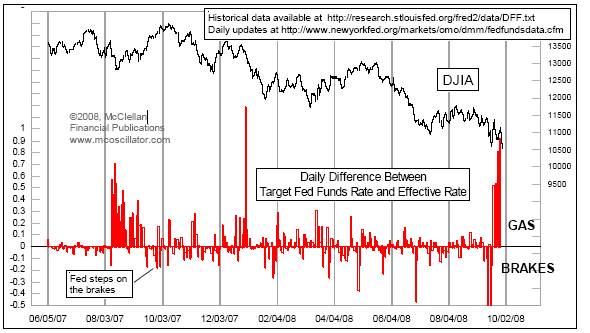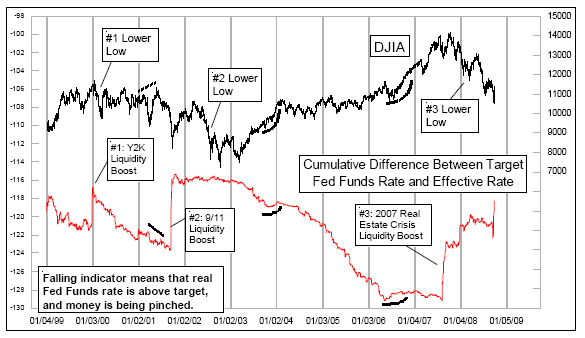|
SATURDAY EDITION April 19th, 2025 |
|
Home :: Archives :: Contact |
 |
The McClellan Market Report - Daily Edition Special AlertMcClellan Financial Publications, Inc. tom@mcoscillator.com www.mcoscillator.com September 29, 2008 With the stock market trying to have a new version of Black Monday, we figured that it was time for another of our very rare special alerts. We last did one on July 26, 2007. The vote in Congress appears to have failed to pass a rejiggered version of the Paulson bailout plan, or whatever name one wants to call it. The stock market was already down strongly ahead of that vote, and the defeat of that bill has pushed the major indices down even further. The natural worry is that the financial markets are going to collapse, and to lead the economy down the drain in the swirling vortex of panic.  Eventually, this is going to turn into a great short term buying opportunity. The reason we say that has to do with the Fedís efforts to throw money at the banking system, independent of the Treasury Departmentís plan to seek to buy up troubled mortgage debt. Last week, the NY Fedís Domestic Trading Desk started injecting extra reserves into the overnight auction of Fed Funds, which is the deposits that member banks loan each other overnight to help maintain their reserve requirements. The FOMC sets the target rate for Fed Funds, and right now that target is 2.00%. That means the NY Fedís Domestic Trading desk is supposed to try to hit that target rate, by adding or subtracting reserves as needed. Going into the stock market bottom on Sep. 17, the Domestic Trading Desk was falling down on the job, as so many banks were coming to that auction seeking reserves that the effective rate got all the way up to 2.80%. The Fed officials appear to have finally woken up, and are added reserves like mad. You can see this in the chart on page 1 where the positive bars mean that the Target FF rate is now well above the effective rate. Friday, Sep. 26, saw an effective FF rate of 1.08%. This sort of injection of money into the banking system is something that the Fed has done in the past, when there have been temporary banking crises. The chart on page 2 shows the same data on the daily comparison of the FF target rate and the effective rate, but instead we are seeing it portrayed on a cumulative basis. The big surges in liquidity resulting from the Domestic Trading Desk lowering the effective rate show up as big upward moves in this cumulative indicator.  We saw an even bigger liquidity boost right after the 9/11 attacks back in 2001. Then too, the effect was to push stock prices up strongly, once the bottom was in. But it was only a temporary relief to a liquidity crisis, and not a complete solution to the underlying problems facing the economy. In 2007, when the real estate marketís collapse first started to be noticed by the Fed, another strong injection of liquidity helped to push the DJIA up from the August 2007 lows to a marginally higher high in October 2007. But it once again did not solve the underlying economic problems, and only served as a temporary surge in money that flamed out. Now we are seeing the Fed dropping money out of helicopters once again. At some point very soon, this extra liquidity is going to finally start to matter to stock prices, and we should see a very robust but brief rally like the examples seen at other times the Fed has done this. That rally will not necessarily mean that the problems are over, but should be seen as one of those times when one should ďnot fight the FedĒ when the Fed is spraying money through a fire hose at the banking system. McClellan Financial Publications, Inc. tom@mcoscillator.com www.mcoscillator.com September 29, 2008 |
| Home :: Archives :: Contact |
SATURDAY EDITION April 19th, 2025 © 2025 321energy.com |
|